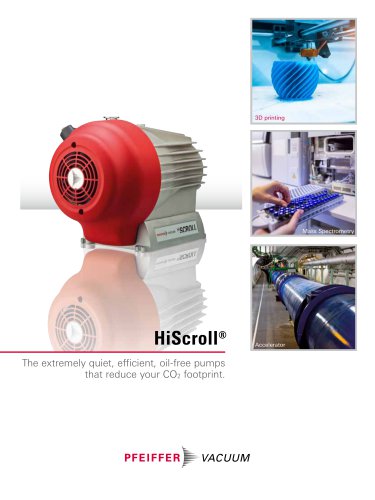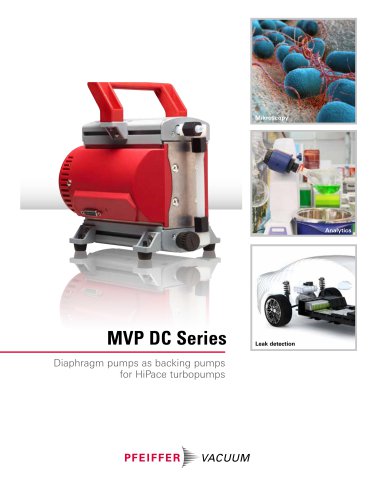 Website:
Pfeiffer Vacuum+Fab Solutions
Website:
Pfeiffer Vacuum+Fab Solutions
Grupo: Busch Group
Excertos do catálogo

A PASSION FOR PERFECTION PFEIFFER ^^VACUUM
Abrir o catálogo na página 1
2 Vacuum Technology and Know how / Contents Vacuum Technology and Know how 1 Introduction to vacuum technology 1.1 General Definition of vacuum . . . . . . . . . . . . . . . . . . . . . . . . . . . . . . . . . . . . . . . . . . . . . . . . . 9 General gas equation . . . . . . . . . . . . . . . . . . . . . . . . . . . . . . . . . . . . . . . . . . . . . . . . 11 Molecular number density . . . . . . . . . . . . . . . . . . . . . . . . . . . . . . . . . . . . . . . . . . . . 12 Thermal velocity . . . . . . . . . . . . . . . . . . . . . . . . . . . . . . . . . . . . . . . . . . . . . . . . . ....
Abrir o catálogo na página 3
2 Vacuum Technology and Know how / Contents 3.3.1 Non-detachable connections . . . . . . . . . . . . . . . . . . . . . . . . . . . . . . . . . . . . . . . . . . 3.3.1.1 Welding . . . . . . . . . . . . . . . . . . . . . . . . . . . . . . . . . . . . . . . . . . . . . . . . . . . . 3.3.1.2 Brazing, fusing and metalizing . . . . . . . . . . . . . . . . . . . . . . . . . . . . . . . . . . 3.3.2 Detachable flange connections . . . . . . . . . . . . . . . . . . . . . . . . . . . . . . . . . . . . . . . . 3.3.2.1 O-Ring seals and grooves . . . . . . . . . . . . . . . . . . . . . . . . . . . . . ....
Abrir o catálogo na página 4
2 Vacuum Technology and Know how / Contents 4.2 Rotary vane vacuum pumps 4.2.1 Design / Operating principle . . . . . . . . . . . . . . . . . . . . . . . . . . . . . . . . . . . . . . . . . . 4.2.2 Application . . . . . . . . . . . . . . . . . . . . . . . . . . . . . . . . . . . . . . . . . . . . . . . . . . . . . . . . 4.2.3 Portfolio overview. . . . . . . . . . . . . . . . . . . . . . . . . . . . . . . . . . . . . . . . . . . . . . . . . . . 4.2.3.1 Single-stage rotary vane vacuum pumps . . . . . . . . . . . . . . . . . . . . . . . . . . 4.2.3.2 Two-stage rotary vane vacuum pumps . . . ....
Abrir o catálogo na página 5
2 Vacuum Technology and Know how / Contents 4.9.1 Design / Operating principle . . . . . . . . . . . . . . . . . . . . . . . . . . . . . . . . . . . . . . . . . . 4.9.1.1 Turbomolecular pump operating principle . . . . . . . . . . . . . . . . . . . . . . . . . . 4.9.1.2 Holweck stage operating principle . . . . . . . . . . . . . . . . . . . . . . . . . . . . . . . 4.9.1.3 Turbopump performance data . . . . . . . . . . . . . . . . . . . . . . . . . . . . . . . . . . . 4.9.2 Application . . . . . . . . . . . . . . . . . . . . . . . . . . . . . . . . . . . . . . . . . . . . . . . . . . . . . ....
Abrir o catálogo na página 6
2 Vacuum Technology and Know how / Contents Contents 7 Leak detection 7.2 Leak detection with tracer gases 119 7.3.2 Comparison of test results with leak detector and 7.5 Industrial leak testing 125 8 Contamination management solutions 8.4 From surface molecular contamination (SMC) to defects 128 www.pfeiffer-vacuum.com PFEIFFER^-MCUUM Part 2 / Page 7
Abrir o catálogo na página 7
BACKING VACUUM Low Vacuum Medium Vacuum Pressure Molecules Mean in 1 cm 3 free path (mbar) Operating ranges of major Vacuum pumps Vacuum gauges Typical vacuum applications Nothern lights Visible interstellar gas nebula Between Earth and Moon Electron microscopy – Nuclear physics – Plasma physics – High energy physics Particle accelerators – Storage rings Cern ion trap Thin layers Space simulation – Cryogenic research Freeze drying – Packaging industry Degasing, casting, dry vacuum smelting (super-pure metals) Incandescent lamp manufacturing Electronic tubes Mechanical + capacitive...
Abrir o catálogo na página 8
1.1 General 1.1.1 Vacuum – Definition A vacuum is defined colloquially as the state encountered in a room at pressures below atmospheric pressure. These pressures can be generated by gases or vapors that are evenly distributed over the room. The standard definition of vacuum is “the state of a gas at which its pressure in a vessel and therefore its particle density is lower than that of the ambient surrounding atmosphere or in which the pressure of the gas is lower than 300 mbar, i. e. lower than the pressure of the atmosphere on the Earth’s surface.“ [2] 1.1.2 Overview of vacuum The...
Abrir o catálogo na página 9
Introduction to vacuum technology 2 Vacuum Technology and Know how / Introduction to vacuum technology In practice, it is very rare that only one gas is available. Mixtures of different gases are much more common. Each single component of these gases will exert a specific pressure that can be measured independently of the other components. This pressure exerted by the various components is called partial pressure. In ideal gases, the partial pressures of the various components add up to the total pressure and do not interfere with each other. The sum of all partial pressures equals the...
Abrir o catálogo na página 10
In space, depending on the proximity to galaxies, pressures of under 10-18 hPa prevail. On Earth, technically generated pressures of less than 10-16 hPa have been reported. The range of atmospheric pressure down to 10-16 hPa covers 19 decimal powers. Specifically adapted types of vacuum generation and measurement for the pressure range result in subdivisions of the various pressure ranges as shown in Table 1.2. The unit for measuring pressure is the pascal. This unit was named after the French mathematician, physicist, writer and philosopher Blaise Pascal (1623 – 1662). According to Formula...
Abrir o catálogo na página 11
Introduction to vacuum technology 2 Vacuum Technology and Know how / Introduction to vacuum technology 1.2.3 Molecular number density As can be seen from Formula 1-7 and Formula 1-8 pressure is proportional to particle number density. Due to the high number of particles per unit of volume at standard conditions, it follows that at a pressure of 10-12 hPa, for example, 26,500 molecules per cm³ will still be present. This is why it is not possible to speak of a void, or nothingness, even under ultra-high vacuum. In space it is increasingly ineffective at extremely low pressures to express...
Abrir o catálogo na página 12
Chemical Symbol The relation between molecular number density and the mean free path is shown in a graph in Figure 1.5. Water vapor Carbon monoxide Carbon dioxide Hydrogen chloride Table 1.5: Mean free path of selected gases at 273.15K [10] Using the values from Table 1.5 we now estimate the mean free path of a nitrogen molecule at various pressures: Pressure [Pa] Pressure [hPa] Mean free path [m] Molecular number density [cm-3] Figure 1.5: Molecular number density (red, right-hand y axis) and mean free path (blue, left-hand y axis) for nitrogen at a temperature of 273.15 K Mean free path...
Abrir o catálogo na página 13Todos os catálogos e folhetos técnicos Pfeiffer Vacuum+Fab Solutions
-
HiQuad Neo
8 Páginas
-
DuoVane 22
4 Páginas
-
Product overview
56 Páginas
-
HiCube Neo
8 Páginas
-
SpeedAir
8 Páginas
-
HiPace 80 Neo
12 Páginas
-
Duo 1.6/M
16 Páginas
-
SmartVane
8 Páginas
-
CenterLine - Total pressure gauges
6 Páginas
-
Compact mass spectrometer - PrismaPro
12 Páginas
-
A 200 L - Multi-stage Roots Pumps
4 Páginas
-
Roots Pumping Stations - CombiLine
16 Páginas
-
Turbo Pumping Stations - HiCube
20 Páginas
-
Gas analysis system HiCube RGA
8 Páginas
-
Contamination Management Solutions
20 Páginas
-
Pascal 2021 HW
4 Páginas
-
Roots Pumps
32 Páginas
-
Vacuum for life
32 Páginas
-
Rotary vane pumps - DuoLine
16 Páginas
-
ActiveLine Gauges
8 Páginas
-
Transmitters - ActiveLine
8 Páginas
-
Vacu² - Multi-Stage Vacuum Process
10 Páginas
-
Duo 3 DC - Rotary vane pumps
4 Páginas
-
HiPace 30 - Turbopumps
4 Páginas
-
Leak Detection Compendium
74 Páginas
-
Chambers and Components (Part 3.3)
399 Páginas
-
Vacuum generation (Part 3.1)
475 Páginas
-
Rotary vane pump - UnoLine Plus
4 Páginas
Catálogos arquivados
-
AMI 1000
8 Páginas




























































